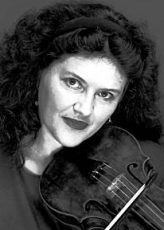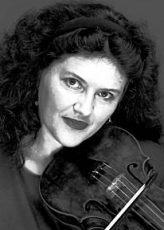
On Valentine’s Day weekend, in four cities, three members of the American Bach Soloists presented a chamber music performance of great variety, including music by such contrasting composers as François Couperin, Heinrich Biber, J.S. Bach, and Arcangelo Corelli. The program selections were a bit disjointed for my taste to say the least, but in the concert I heard Sunday at St. Mark’s Lutheran Church in San Francisco the performers managed to tie things together well enough, balancing fireworks with remarkable poise and an elegant intimacy.
The audience responded with predictable enthusiasm to violinist Elizabeth Blumenstock’s fiery virtuosity. As she dug into some of Corelli’s more furious variations on the famous bassline called “La Follia” (Op. 5, No. 12), spontaneous combustion of her violin seemed possible. (In point of fact, one of her fiddles did explode the night before, and she therefore played some of Sunday’s concert on a borrowed violin.) Some of the tempos in this piece were as fast as I’ve ever heard them, and one of the syncopated variations was so wild and wooly that members of the audience were laughing and hooting before its finish.
Blumenstock seemed to be doing her best to channel Corelli, whose eyes, according to the 18th-century diarist François Raguenet, “will sometimes turn as red as fire; his countenance will be distorted, his eyeballs roll as in agony.” The virtuoso Blumenstock followed her illustrious model with aplomb, and the audience was thrilled.
Throughout the evening, harpsichordist Corey Jamason and gambist Steve Lehning proved themselves sensitive and able musicians, integral to the fabric of the music in a way that was downplayed by the publicity material for the concert. In fact, it is difficult to find much to criticize about the performance that night, but the PR people for the American Bach Soloists deserve a sharp slap on the wrist for titling this program “Elizabeth Blumenstock in Concert.” Blumenstock is hardly a megalomaniac, and she made no attempt to dominate either the musical textures or the program selections.
Creative Approach to Couperin
The opening suite by Couperin was a case in point. Blumenstock emphasized the intimacy and collaborative nature of the group’s arrangement of this piece by cozying up to her partners and sitting down next to Jamason (she stood for some of the more soloistic parts of the program). The work was drawn from a set of pieces called Concerts Royaux, suites of dances scored on two staves (like keyboard music), though with an indication from the composer that they can be performed on any combination of wind and string instruments. Fortunately, Couperin was no more specific than this, thus letting performers enjoy a great measure of freedom in selecting the instruments to use and also in arranging the pieces to fit their particular instrumental makeup.
The Courante in this suite showed off the group’s creative approach to Couperin’s flexible notation. The form of this dance is a so-called binary structure, with two halves, each of which is repeated. (Analysts use the letters AA, BB to describe the overall form.) Jamason presented the first half of each binary section alone as a harpsichord solo. This was a wonderful idea, since the Courante is a dance greatly dependent on a particular rhythmic suavity often accommodated best by a solo player, and a dance idiomatically suited to the harpsichord. Jamason’s sensitive and galant rendering set the tone perfectly for the other players, who picked up the rhythmic gait with ease.
The ensemble botched the Sarabande somewhat, taking its marking “grave” a tad too seriously. Their interpretation was creepingly slow, asking the piece to provide too much contrast to the lilting, moderate movements that surrounded it. This music is not about stark contrasts, but about subtle gradations of color and nuance, an approach that the French called galant. The interpretation of this Sarabande was the one moment in this concert when the performers asked the music to do something that it wasn’t designed to do.
Yet they made up for this gaffe, in spades, with the rest of the suite. Lehning’s playing was incomparable. He’s well-suited to this sort of elegant repertoire, contributing the so-called contrapartie (extra melodic lines composed by Couperin for this suite) with remarkable grace and a lovely, quiet competence. His dissonant double stops on the Muzette simply “made” the piece for me, perfectly capturing the imaginative pastoral mood. It simply wouldn’t have sounded like a bagpipe without these drones.
Nonpareil Performance by Corey Jamason
Space doesn’t allow me to review every piece on the concert; still, I must say at least something about Jamason’s performance of Bach’s famous Chromatic Fantasy and Fugue. This was, put simply, the best performance I’ve ever heard of this piece, including past renditions by the artist himself. The opening fantasy is a whirlwind of virtuoso, rococo filigree; and it’s all too easy to reduce these spinning lines to nonsensicality in attempting to embody a flight of fancy. Jamason was plenty exciting, but also managed to maintain an elegant poise, moving from sweeping line to harmonic point of tension or stasis with exactly the right inflections.
His harpsichord touch was phenomenal, and those listeners who believe the instrument incapable of dynamic contrast could have received a sharp corrective from Jamason’s ebbs and tides in this fantasy. The fugue suffered a bit from a virtuoso tempo in such a resonant space as St. Mark’s, which left the tortured chromatic subject and dense counterpoint a little hazy. But the pacing and phrasing were precisely right, and the interference may well have been due to where I was sitting.
If only I had more space, I’d wax poetic about Blumenstock’s equally rhapsodic performance of Bach’s Solo Sonata in G Minor, BWV 1001, or about the remarkably poised approach to Biber’s fifth Rosary Sonata. Nevertheless, take it as high praise that all that was right with this concert elicits more words than space allows — and more enthusiasm from me than words can adequately express. Bravi!

